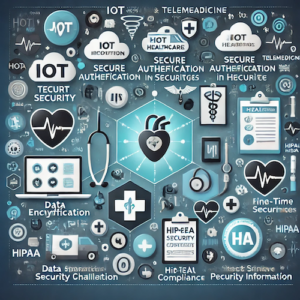You know the scenario all too well. Doctors and management are buzzing about the latest breakthroughs in remote monitoring, wearable health devices, and the tantalizing promise of enhanced patient outcomes. A tech utopia, they say. Yet, while the excitement swirls, you’re the one tasked with the intricate dance of telemedicine IoT integration.
You’re on a mission to seamlessly weave these IoT medical sensors into your existing systems, safeguard data like Fort Knox, and juggle an ever-expanding tech infrastructure. No pressure, right? Fear not! This blog is your guide to navigating these challenges with savvy solutions and sharp insights, turning what could be a migraine into a manageable mission.
And the payoff? A leap into value-based care where both providers and patients are empowered to take charge, optimizing outcomes and trimming costs. It’s more than just an upgrade—it’s a full-on shift toward a smarter, seamlessly connected future of healthcare.
Top Takeaways:
- Telehealth IoT integration simplifies remote monitoring by enabling continuous patient data collection through wearables and sensors. When done right, this approach can lead to fewer unnecessary hospital visits and better chronic care management, reducing the overall burden on healthcare providers.
- Projects involving IoT telemedicine integration prioritize ensuring that existing data handling systems, particularly within EHR and telemedicine platforms, are already top-notch. These initiatives often rely on health data integration engines and HIPAA-compliant tools to secure data transmission and optimize both operational efficiency and patient care.
- You can create a more responsive, patient-centric healthcare environment through personalized health alerts and real-time monitoring of vital signs, where IoT telehealth integration empowers both patients and providers to foster better engagement and more proactive care interventions, driving transformation across the healthcare industry.
Table of Contents:
- IoT and Telemedicine Integration Overview
- Strategic Reasons to Integrate Telemedicine and IoT
- Areas of IoT Integration with Telehealth
- Challenges of Integrating Telemedicine and the Internet of Things
- Steps to Integrate Telehealth and IoT
- Tech Stack for Integrating Telemedicine and IoT
- Best Practices for Telemedicine IoT Device Integration
- Costs of Telemedicine and IoT Integration
- Overcoming IoT and Telemedicine Security and Privacy Challenges
- The Future of IoT and Telemedicine Integration
- How Topflight Can Help?
IoT and Telemedicine Integration Overview
Merging the Internet of Things with telemedicine is more than just a tech upgrade; it’s a game-changer for enhancing patient care and boosting operational efficiency.
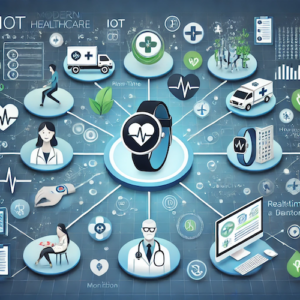
What is IoT in Telemedicine?
At its essence, IoT in telemedicine is about leveraging connected devices to capture and transmit patient data in real-time. This sophisticated setup ensures a continuous, seamless flow of information between patients and healthcare providers, facilitating timely and accurate medical interventions.
Key elements include:
- Remote Monitoring: Picture IoT devices such as smart wearables and in-home health sensors, tirelessly gathering patient data, thus minimizing unnecessary hospital visits.
- Data Interoperability: Ensures that information from IoT devices meshes seamlessly with existing electronic health records (EHR), thereby elevating traditional telehealth systems.
- Telemedicine IoT Device Integration: This pivotal process embeds IoT capabilities within telemedicine frameworks, revolutionizing healthcare delivery.
Working with a seasoned healthcare app developer ensures seamless integration of these technologies.
Market Overview
The healthcare landscape is being reshaped by the rapid embrace of IoT in telemedicine. Decision-makers find themselves navigating a fast-evolving environment characterized by explosive growth in connected technologies.
Market Growth
The IoT healthcare market, valued at $44.21 billion in 2023, is expected to grow at a 21.2% CAGR until 2030, with many of the best telemedicine apps already incorporating IoT devices. The telemedicine market is set to reach $286.22 billion by 2030, reflecting a 17.2% CAGR.
Investment in IoT
By 2025, IoT adoption in healthcare is expected to hit 87%, as organizations prioritize connected devices for superior patient monitoring and data gathering. Already, around 60% of healthcare entities are utilizing IoT devices, showcasing the industry’s swift embrace of these technologies for real-time analytics and proactive care.
Wearables and IoMT Expansion
The global Internet of Medical Things (IoMT) market is on track to reach $187.60 billion by 2028, a massive leap from its 2020 valuation of $41.17 billion.
Strategic Reasons to Integrate Telemedicine and IoT
Integrating IoT with telemedicine is like finding the ultimate shortcut to efficiency and innovation. The synergy of these technologies promises not only enhanced patient care but also streamlined operations that can make any healthcare facility a powerhouse of efficiency and responsiveness.
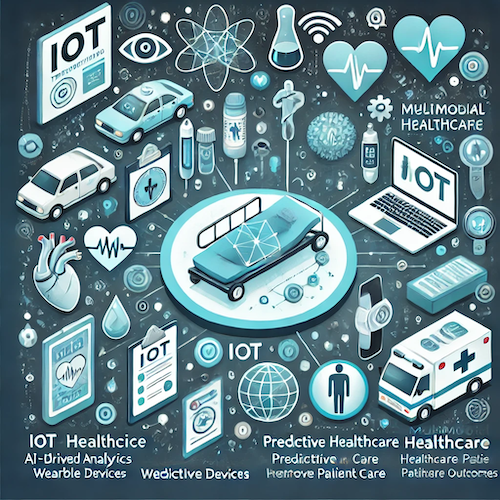
Enhancing Remote Patient Monitoring and Data Sharing
The integration of IoT within telemedicine allows healthcare providers to monitor patients remotely with unprecedented accuracy and timeliness. Imagine a scenario where real-time data from medical equipment is seamlessly shared with healthcare professionals, ensuring that critical decisions are made proactively rather than reactively.
- Reduction in Hospital Readmissions: IoT-enabled remote monitoring has demonstrated an up-to 45% decrease in hospital readmissions in some cases, a KPI that any healthcare leader would be thrilled to report.
- Data Sharing Efficiency: By using IoT in telemedicine and healthcare integration, patient data is not just collected; it’s shared and analyzed in real-time, e.g. through using Allscripts EHR integration, leading to faster and more informed medical interventions.
Reducing Operational Costs and Improving Efficiency
Every healthcare facility dreams of optimizing operations without cutting corners. Integrating IoT with telemedicine can make this dream a reality. From asset tracking of medical equipment to predictive maintenance, IoT offers a treasure trove of efficiency improvements.
- Cost Reductions: Facilities utilizing IoT technology have reported an average operational cost reduction of 26%. This is achieved through better utilization of resources and minimized waste.
- Efficiency Boost: IoT provides the backbone for efficient telemedicine operations, leading to an up-to 50% reduction in patient wait times. This improvement not only saves time but also boosts patient satisfaction.
Improving Patient Outcomes and Engagement
Patient care is as much about quality as it is about engagement. With IoT-driven telemedicine, healthcare providers can offer personalized care plans tailored to individual needs, enhancing both outcomes and patient involvement.
- Medication Adherence: IoT-based systems have been shown to improve medication adherence rates by 15-20%, ensuring patients follow through with prescribed treatments.
- Patient Engagement: By providing patients with access to their health data and insights, IoT devices foster a more informed and engaged patient population.
Providing real-time health data fosters better patient engagement and outcomes, a strategy that can also help grow a medical practice.
Addressing Compliance, Security, and Regulatory Requirements
Navigating the complex waters of compliance and security in the digital age is no small feat. The integration of IoT with telemedicine must prioritize these elements to ensure seamless operation within regulatory frameworks.
- Security Measures: As IoT sensors become integral to healthcare, ensuring their security is paramount. Advanced encryption and regular updates mitigate risks, safeguarding sensitive patient data.
- Regulatory Compliance: By adhering to strict guidelines and leveraging IoT for asset tracking, healthcare facilities can ensure compliance with industry standards, avoiding costly penalties and maintaining trust with patients.
Areas of IoT Integration with Telehealth
As we delve into the transformative world of IoT and telehealth, it’s crucial to highlight how these two powerhouses combine to elevate healthcare delivery. Decision-makers are tasked with ensuring that these integrations not only enhance care but also optimize operations.
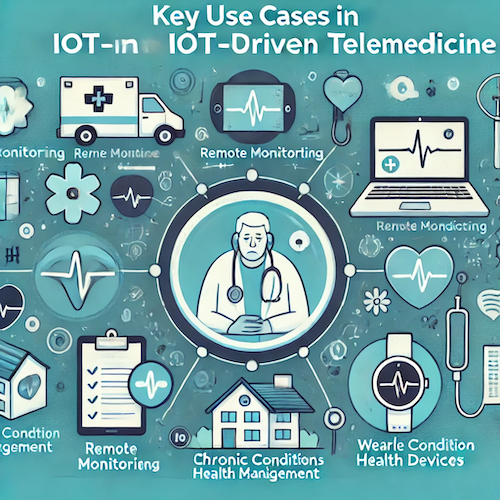
Key Use Cases in IoT-Driven Telemedicine
The landscape of telehealth is brimming with possibilities thanks to IoT. Here are some standout examples:
- Chronic Condition Management: IoT devices excel in managing chronic conditions by continuously tracking health metrics like blood pressure and vital signs. This constant monitoring allows for proactive care adjustments, improving patient outcomes.
- Telehealth Remote Care: Through integration of IoT telehealth, patients can receive care beyond the confines of traditional healthcare settings. This approach enhances access and continuity of care, tailored to patient needs.
Integration with Existing Healthcare Systems
Seamlessly blending IoT solutions with existing systems is key to maximizing their benefits:
- Health Monitoring Networks: Establishing robust networks for efficient data flow ensures real-time health monitoring. This supports quick decision-making and enhances system uptime, a crucial KPI for healthcare leaders.
- Communications and Data Interoperability: Ensuring that IoT devices communicate effectively with traditional systems is vital for comprehensive data analysis and improved patient care.
Challenges of Integrating Telemedicine and the Internet of Things
Navigating the integration of IoT into telemedicine is no small feat, especially when the goal is to optimize operational efficiency and enhance patient care. As a tech healthcare leader, you’re tasked with addressing a myriad of challenges that come with this technological evolution.
Integration with Legacy Systems
The seamless integration of new IoT technologies with existing legacy systems can be a daunting task.
- Interoperability: Ensuring that new IoT solutions can communicate effectively with existing medical devices and systems is vital for comprehensive medical care delivery.
- Custom Integration Solutions: Tailored approaches may be required to bridge the gap between old and new technologies, ensuring a smooth transition without disrupting service delivery.
Ensuring Data Accuracy and Real-time Availability
Accurate and timely data is the backbone of effective medical care. In the realm of IoT, ensuring this standard can be challenging.
- Real-Time Monitoring: Implementing reliable network infrastructure is crucial for real-time data availability, enabling healthcare providers to make timely decisions.
- Data Validation Protocols: Establishing rigorous data validation processes ensures the integrity of the information received from various IoT medical devices.
Managing Technical Debt and IT Infrastructure
Integrating IoT with telemedicine doesn’t just involve new technology; it requires a reevaluation of existing IT infrastructure to manage technical debt effectively.
Investing in updated hardware and software that can support the demands of IoT technology is essential for long-term success. You should also seriously consider balancing the budget for upgrades while optimizing IT expenditures for maintaining financial health without compromising on technological advancement.
Security and Privacy Concerns in IoT Devices
One of the most pressing concerns in telehealth internet of things integration is safeguarding patient data. With IoT devices capturing and transmitting sensitive health information, robust security measures are essential. We discuss tackling security challenges when blending medical IoT with telehealth software in a dedicated section below (Overcoming IoT and Telemedicine Security and Privacy Challenges).
Steps to Integrate Telehealth and IoT
Diving into integration with IoT telemedicine isn’t just a walk in the park; it demands a savvy mix of strategy and tech know-how to pull off a seamless implementation and boost healthcare delivery. Here’s your roadmap to success:
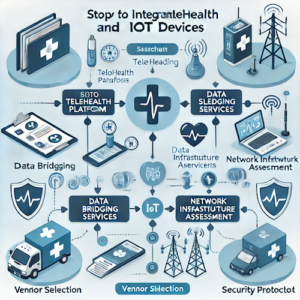
- Telehealth Platform Analysis: Kick things off by scrutinizing your telehealth platform. Does it play nice with connectivity APIs for a plug-and-play setup, or are you considering how to create a telehealth app from scratch?
- Evaluating Data Bridging Services: Next up, see if you need Mirth or similar data bridging services to keep the data flowing smoothly between systems that usually don’t chat. For example, if you’re planning to build a doctor appointment app for patient scheduling.
- Data Mapping with Built-in EHR: Dive deep into data mapping to ensure everything syncs perfectly with your EHR system. Interoperability with existing EHR platforms, such as integrating a health app with Epic EHR/EMR, is crucial for efficient healthcare data management.
- Network Infrastructure Assessment: Check your network’s pulse. Can it handle the data deluge from IoT devices? Look at bandwidth, latency, and security to keep things running smoothly.
- Security Protocol Implementation: Lock it down! Implement top-notch security protocols to safeguard sensitive patient data. Think encryption, secure authentication, and regular security check-ups.
- Compliance Verification: Make sure you’re playing by the rules. Whether it’s HIPAA in the U.S. or GDPR in Europe, team up with legal and compliance to ensure your IoT solutions are up to snuff.
- Testing and Validation: Put your system through its paces with thorough testing. Validate data flow, security, and performance to ensure everything works like a charm in the real world.
- Deployment Planning and Phasing: Craft a deployment plan with phased rollouts, starting with a pilot phase. Use the insights gained to fine-tune your strategy before going big across the organization.
Now that you’ve got the roadmap, let’s dive into how to bring it all together and ensure your telehealth and IoT integration is not just functional but transformative.
Assessing Organizational Readiness for IoT Integration
Before integrating IoT with telehealth, it’s vital for healthcare organizations to assess their current infrastructure and readiness. Start by analyzing existing systems to determine compatibility with IoT solutions, identifying necessary upgrades to support new technologies.
Define clear objectives and relevant KPIs, such as system uptime and operational efficiency, to guide the integration process. Allocating the right resources, both human and technological, is crucial. This includes having skilled IT personnel and robust technical infrastructure in place to support the transition smoothly.
Effective integration requires seamless workflows between IoT systems and medical patient scheduling software to optimize appointment booking and patient management.
Key Considerations in Vendor Selection
Choosing the right partners can make or break your IoT telemedicine integration project. Here’s how to approach vendor selection:
- Comprehensive Evaluation: Look for vendors with a proven track record in healthcare IoT solutions, and refer to a doctor-on-demand app development guide to ensure you’re including key features needed for IoT integration. Assess their ability to deliver scalable and secure systems.
- Interoperability Focus: Ensure that the vendor’s solutions can easily integrate with your existing systems, facilitating seamless data flow and communication.
- Support and Maintenance: Opt for vendors who offer ongoing support and maintenance services. This ensures that your IoT system remains up-to-date and functional.
Read more on healthcare app development
Integration Strategies for Seamless IoT and Telemedicine Operations
Establishing a strategy is essential for a smooth integration process. Begin with small-scale pilot programs to test the integration and gather insights, allowing necessary adjustments before a full-scale rollout. Training and education are paramount; equip your team to handle new IoT systems with confidence.
Implement continuous monitoring to keep track of performance and gather feedback, enabling data-driven enhancements.
The ultimate goal of this integration is to:
- achieve a more connected and responsive healthcare environment
- align technological investments with operational goals and patient needs.
It’s essential to choose an EHR system that can fully support IoT data collection and analysis.
Tech Stack for Integrating Telemedicine and IoT
Successful internet of things telehealth integration requires a carefully selected tech stack. This comprehensive approach ensures that healthcare organizations can leverage IoT capabilities to enhance telehealth services effectively. Here’s a breakdown of key components in an effective tech stack, along with specific examples and how they address common integration challenges:
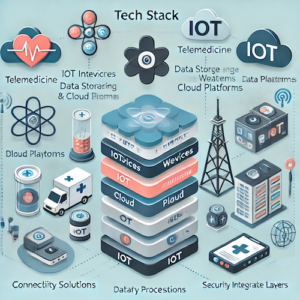
IoT Devices and Sensors
Examples:
- Withings Blood Pressure Monitor
- Dexcom G6 Continuous Glucose Monitoring System
- AliveCor KardiaMobile EKG Monitor
Addresses: Data collection challenges, ensuring accurate and continuous patient monitoring.
Connectivity Solutions
Examples:
- Cellular (4G/5G): For mobile and remote patient monitoring
- LoRaWAN: For long-range, low-power device connectivity
- Bluetooth Low Energy (BLE): For short-range, energy-efficient connections
Addresses: Data transmission challenges, especially in areas with limited internet access.
IoT Platforms
Examples:
- AWS IoT Core: Scalable cloud platform for device management and data processing
- Microsoft Azure IoT Hub: Secure bi-directional communication between IoT devices and applications
- Google Cloud IoT Core: Fully managed service for connecting and managing IoT sensors
Addresses: Device management, scalability, and data processing challenges.
Data Storage and Processing
Examples:
- InfluxDB: Time-series database optimized for IoT data
- Apache Cassandra: Highly scalable, distributed NoSQL database
- Apache Kafka: Distributed event streaming platform for real-time data pipelines
Addresses: Handling large volumes of real-time data and ensuring quick data retrieval for analysis.
Before integrating IoT, it’s crucial to assess whether to buy or build a telehealth solution based on your long-term operational goals.API Integration Layer
Examples:
- MuleSoft Anypoint Platform: API management and integration platform
- Apigee API Management: Secure and scalable API gateway
- Kong API Gateway: Open-source API gateway for microservices management
Addresses: Interoperability challenges, enabling seamless communication between different systems and devices.
Security and Compliance Tools
Examples:
- Palo Alto Networks IoT Security: AI-powered IoT security platform
- Armis: Agentless IoT security platform
- Zingbox: AI-powered IoT guardian
Addresses: Security and privacy concerns, ensuring HIPAA compliance and protection against cyber threats.
Data Analytics and AI
Examples:
- TensorFlow: Open-source machine learning framework for predictive analytics
- H2O.ai: AutoML platform for building AI models
- Databricks: Unified analytics platform for big data processing and machine learning
Addresses: Extracting meaningful insights from IoT data, enabling predictive care and personalized treatment plans.
Mobile and Web Development Frameworks
Examples:
- React Native: Cross-platform mobile app development framework
- Flutter: Google’s UI toolkit for building natively compiled applications
- Vue.js: Progressive JavaScript framework for building user interfaces
Addresses: Creating user-friendly interfaces for patients and healthcare providers to interact with IoT data and telehealth services.
Consider whether your organization will also need to develop a wearable app for Wear OS and WatchOS to fully integrate with telemedicine systems.
By leveraging these specific technologies and tools, healthcare organizations can build a robust tech stack that addresses the unique challenges of integrating IoT with telemedicine. This approach ensures scalability, security, and interoperability while enabling the development of powerful, user-friendly solutions.
Ultimately, a well-designed tech stack is crucial for successful internet of things telehealth integration, paving the way for improved patient care and operational efficiency in healthcare.
Best Practices for Telemedicine IoT Device Integration
Effectively integrating IoT devices into your telemedicine framework involves strategic planning and execution. Here are some best practices to consider:
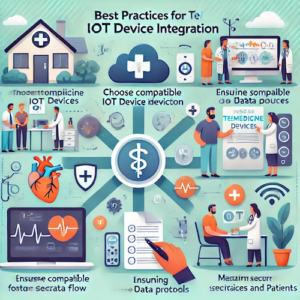
Standardization
Use standardized protocols and APIs to ensure devices can communicate efficiently and consistently across platforms.
Performance Monitoring
Implement continuous monitoring systems to track device performance and identify potential issues before they impact operations.
User Training
Equip your team with the necessary training to operate and troubleshoot IoT devices, ensuring smooth day-to-day functionality.
System Stress Testing
Conduct regular stress testing on IoT systems to evaluate performance under peak loads, ensuring they can handle real-world usage without hiccups.
Firmware Updates
Regularly update the firmware on medical devices to maintain security and functionality, safeguarding against vulnerabilities and ensuring compliance with the latest standards.
Beyond these essentials, consider the long-term lifecycle of devices within your internet of medical things telehealth integration. As technology advances, devices will need to evolve without disrupting existing operations. This calls for a robust update mechanism and a forward-thinking approach to device management, ensuring that your telemedicine infrastructure remains agile and future-proof.
UI/UX Mastery
Beyond basic integration, focus on healthcare mobile app design to create user-friendly platforms that enhance both provider and patient experiences.
Hybrid Approaches for IoT and Telehealth Platforms
Hybrid solutions offer the best of both worlds, combining on-premise and cloud-based resources to optimize performance and flexibility in IoT telehealth integration.
- Cost Efficiency: Leverage cloud resources for data storage and processing, reducing the need for costly onsite infrastructure.
- Data Processing: Use on-premise systems for real-time data processing and critical functions that require low latency.
- Resiliency and Redundancy: Hybrid models provide redundancy, ensuring system uptime and reliability even during unexpected disruptions.
IoT integration often uncovers hidden complexities in the workflow, which can be alleviated by medical practice automation solutions.
Costs of Telemedicine and IoT Integration
Embarking on the journey of device integration in IoT telehealth is akin to investing in the future of healthcare delivery. The financial landscape here is nuanced and depends heavily on whether you’re starting from scratch or building atop an existing platform. Let’s break down the costs involved to paint a clearer picture.
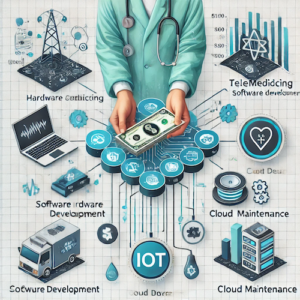
Initial Setup Costs: Telehealth Platform
Starting fresh? The initial investment for telemedicine systems can range widely, from about $15,000 to a staggering $200,000. This variation typically hinges on the scale and capabilities of the platform—whether you’re looking for something straightforward or a system packed with advanced features like AI-driven analytics.
Integrating IoT Infrastructure
Once your telehealth platform is in place, integrating IoT infrastructure comes next. Anticipate an additional $30,000 to $50,000 to seamlessly connect IoT devices with your telemedicine system. This step is crucial for achieving the real-time data exchange that modern healthcare demands.
Facilities using IoT technology report significant cost savings, especially when integrating AI in medical billing and coding to streamline billing.
Large-Scale Development
For those venturing into large-scale healthcare software development that integrates multiple devices, prepare for investments around $70,000. This ensures a robust system that can handle diverse functionalities and scale with your organization’s needs.
- Hardware Costs: Don’t forget about the hardware! Costs here can vary dramatically based on the types of devices you choose to integrate. From basic monitoring gadgets to sophisticated wearables, each comes with its own price tag.
Financial Savvy in Telehealth Investment
The goal is to balance these costs while optimizing operational efficiency and maintaining system uptime. By aligning investments with strategic objectives, it’s possible to maximize ROI and ensure IT budget optimization without compromising patient satisfaction.
In essence, while the upfront costs of device integration in IoT telehealth might seem daunting, the potential for long-term savings, improved patient outcomes, and streamlined workflows makes it a worthwhile endeavor. For instance, in one case, remote monitoring of high-risk pregnancies resulted in annual cost reductions of $233,958 by replacing extended hospital admissions.
Overcoming IoT and Telemedicine Security and Privacy Challenges
In the world of integrated IoT telemedicine, ensuring robust data security and privacy is not just a box to tick—it’s a cornerstone of sustainable healthcare solutions. As a Healthcare CIO, you’re on the front lines, safeguarding sensitive patient data while maintaining seamless operations. Let’s delve into practical strategies for overcoming these challenges.
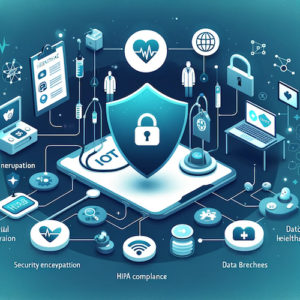
Strategies for Securing IoT Devices in Healthcare
Securing IoT devices begins with a comprehensive approach that combines technology, process, and people. Here are some key strategies:
- Device Authentication and Authorization: Ensure that every device connecting to your network is authenticated and authorized. Implement strong password policies and two-factor authentication.
- Data Encryption: Encrypt data both at rest and in transit to protect sensitive information from unauthorized access. This ensures that even if data is intercepted, it remains unreadable to potential threats.
- Regular Security Audits: Conduct regular security assessments and vulnerability scans to identify and address potential weak points. Keeping a proactive stance can prevent breaches before they occur.
- Network Segmentation: Isolate IoT sensors on a separate network to limit the potential impact of a security breach. This minimizes access to critical systems and data.
- Firmware Updates: Keep IoT devices up-to-date with the latest firmware updates to patch known vulnerabilities and enhance security features.
By prioritizing these strategies, healthcare organizations can create a resilient security framework that protects both patient data and the integrity of the telemedicine system.
HIPAA Compliance and IoT Data Transmission
Navigating HIPAA compliance within integrated IoT telemedicine requires diligence and foresight. Here’s how to align with regulatory standards:
- Data Minimization: Collect only the data necessary for patient care to reduce exposure and potential liability. This limits the volume of sensitive information that needs protection.
- Access Controls: Implement strict access controls to ensure that only authorized personnel can access patient data. Role-based access can help in managing permissions effectively.
- Audit Trails: Maintain comprehensive audit logs of all data access and transmissions. This not only aids in compliance but also provides a trail for investigating any irregularities.
- Training and Awareness: Regularly train staff on HIPAA regulations and data protection best practices. Ensuring that everyone is informed helps create a culture of security.
Maintaining HIPAA compliance while leveraging IoT innovations is a delicate balance. Yet, by integrating these strategies into your security framework, you can protect patient data effectively while reaping the benefits of telemedicine advancements.
The Future of IoT and Telemedicine Integration
As we chart the course for integrating IoT telehealth, the future promises to be a tapestry woven with innovation and enhanced patient care. For Healthcare CIOs, this evolution means strategically aligning with technologies that drive operational efficiency, bolster system reliability, and optimize budgets, all while elevating patient satisfaction.
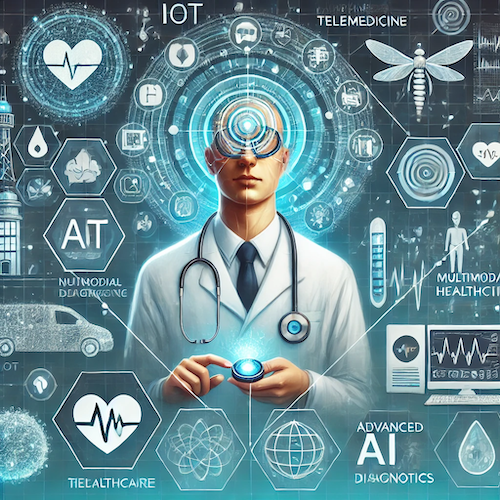
AI and Predictive Analytics
AI stands at the forefront of this transformation. Predictive analytics, powered by AI, can foresee patient health trends and potential issues, allowing for preemptive interventions. This capability not only reduces system disruptions but also ensures continuous patient care, leading to better health outcomes.
- Proactive Device Management: AI can predict when IoT devices need maintenance, ensuring uninterrupted service and reducing unexpected downtime.
Expanding IoT for Personalized Patient Care
Personalized healthcare is becoming the norm, driven by IoT’s ability to tailor treatment plans based on real-time data. This personalized approach not only improves patient engagement but also enhances adherence to treatment, contributing to improved outcomes.
- Individualized Alerts: IoT devices can be configured to deliver patient-specific alerts, such as medication reminders, reducing the likelihood of missed doses and hospital visits.
Multimodal Healthcare with IoT and Wearables
The integration of wearables into IoT telehealth systems is revolutionizing multimodal care. These devices offer continuous streams of health data, providing a holistic view of patient health and enabling more accurate diagnoses.
- Integrated Data Systems: Wearables allow for seamless data integration, giving healthcare providers a comprehensive view of patient records which enhances diagnostic accuracy and treatment planning.
How Topflight Can Help?
Navigating the complexities of telemedicine IoT integration doesn’t have to be a solo journey. At Topflight, we’re committed to guiding healthcare organizations through the dynamic landscape of IoT integration with precision and expertise.
Dedica Health: A Case in Point
Our collaboration with Dedica Health exemplifies how we turn visions into reality. This project involved transforming The Heart Medical Group’s care delivery model by deploying a robust remote patient monitoring platform. The platform seamlessly integrates with certified medical sensors, allowing healthcare providers to monitor over 1,100 patients daily. This shift not only adhered to Medicare RPM guidelines but also boosted operational efficiencies by automating back-office routines and reducing manual tasks.
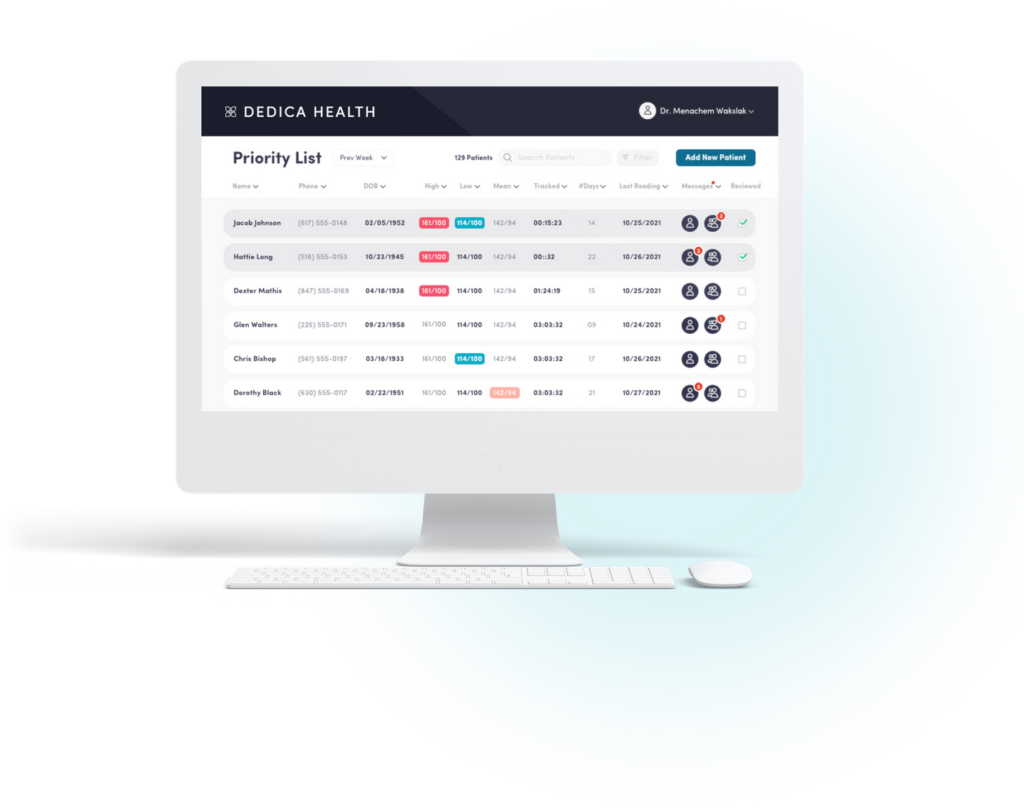
Key achievements include:
- physicians can now manage patient data more effectively, ensuring timely and informed decisions.
- the platform’s seamless integration with medical sensors and its adherence to HIPAA standards showcase our partner’s commitment to scalability and data security.
- the introduction of a SaaS model contributed to a $300,000 ARR, illustrating the financial benefits of effective telemedicine solutions.
Comprehensive Support for Healthcare Leaders
Beyond Dedica Health, our portfolio showcases diverse projects like Walker Tracker (an award-winning employee wellness platform acquired by Terryberry) and iFaint (developed for the Stanford University School of Medicine), reflecting our ability to cater to various healthcare needs. Our approach is holistic, ensuring that every solution is tailored to enhance patient outcomes, optimize IT budgets, and improve system uptime.
At Topflight, we understand that telemedicine IoT integration isn’t a one-size-fits-all solution. Whether it’s enhancing remote patient monitoring or integrating wearables for real-time data sharing, our team is equipped to turn your technological aspirations into tangible outcomes. By leveraging our expertise, healthcare organizations can seamlessly integrate IoT solutions, ensuring a future-ready platform that meets today’s demands and tomorrow’s challenges.
Let us help you chart a course towards a smarter, more connected healthcare system. With Topflight, the future of telehealth IoT integration is within reach.
Frequently Asked Questions
How does IoT integration enhance telemedicine services?
IoT integration boosts telemedicine by enabling real-time data exchange, allowing healthcare providers to deliver personalized care and engage patients more effectively. It shifts healthcare from reactive to proactive by facilitating continuous monitoring.
What are security measures for IoT devices in telemedicine?
Essential security measures include encryption, regular updates, and strong authentication. Employing network segmentation and a zero-trust model further protects sensitive patient data, ensuring only verified access.
How does IoT improve real-time patient monitoring in telemedicine?
IoT devices allow for continuous monitoring, providing real-time alerts on patient conditions. This helps in timely interventions and improves patient outcomes, empowering patients in their health management.
What are the challenges of integrating IoT with telemedicine platforms?
Key challenges include ensuring data security, compatibility with existing systems, and managing data accuracy. Addressing regulatory compliance and technical debt are also critical in successful integration.
Can IoT-enabled devices easily integrated with existing telemedicine systems?
Yes, with the right strategy, integration is achievable. Assess current systems for compatibility, choose interoperable devices, and partner with experienced vendors to make the process seamless and scalable.
